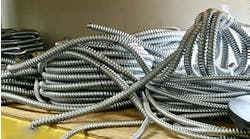Courtesy of www.MikeHolt.com.
All questions and answers are based on the 2023 NEC.
Q1: Underground _____ shall be installed so they are accessible without excavating sidewalks, paving, earth, or other substance that is to be used to establish the finished grade.
a) boxes and handhole enclosures
b) conduit bodies
c) handhole enclosures
d) none of these
Q2: When nongrounding-type receptacles are replaced by GFCI-type receptacles where attachment to an equipment grounding conductor does not exist in the receptacle enclosure, _____ shall be marked "No Equipment Ground."
a) the receptacle
b) the protective device
c) the branch circuit
d) these receptacles or their cover plates
Q3: Unused openings for circuit breakers and switches in switchboards and panelboards shall be closed using _____, or other approved means that provide protection substantially equivalent to the wall of the enclosure.
a) duct seal and tape
b) identified closures
c) exothermic welding
d) sheet metal
Q4: Where a branch circuit supplies continuous loads and/or noncontinuous loads, the rating of the overcurrent device shall not be less than the noncontinuous load plus _____ of the continuous load.
a) 80%
b) 115%
c) 120%
d) 125%
Q5: Where conduit or tubing is used for the protection from physical damage of Type NM cable, it shall be provided with a bushing or adapter that protects from abrasion at the point where the cable _____ the raceway.
a) enters and exits
b) leaves and comes into
c) begins and ends
d) none of these
Q6: Power-supply cords, communications cables, connecting cables, interconnecting cables, and associated boxes, connectors, plugs, and receptacles that are listed as part of, or for, information technology equipment shall not be required to be secured in place where installed _____.
a) above suspended ceilings
b) exposed on interior walls
c) under raised floors
d) exposed on exterior walls
Answers:
Q1: a) boxes and handhole enclosures
Section 314.29(B) states, "Underground boxes and handhole enclosures shall be installed so they are accessible without excavating sidewalks, paving, earth, or other substance that is to be used to establish the finished grade."
Q2: d) these receptacles or their cover plates
Per Sec. 406.4(D)(2)(b): "These receptacles or their cover plates shall be marked 'No Equipment Ground.'"
Q3: b) identified closures
According to Sec. 408.7, "Unused openings for circuit breakers and switches shall be closed using identified closures, or other approved means that provide protection substantially equivalent to the wall of the enclosure."
Q4: d) 125%
Section 210.20(A) states, "The rating of the overcurrent device shall not be less than the noncontinuous load plus 125% of the continuous load."
Q5: a) enters and exits
Per Sec. 334.15(B): "Conduit or tubing shall be provided with a bushing or adapter that provides protection from abrasion at the point the cable enters and exits the raceway."
Q6: c) under raised floors
Section 645.5(F) confirms, "Power-supply cords; communications cables, connecting cables, interconnecting cables, and associated boxes, connectors, plugs, and receptacles that are listed as part of, or for, information technology equipment shall not be required to be secured in place where installed under raised floors."
These materials are provided by Mike Holt Enterprises in Leesburg, Fla. To view Code training materials offered by this company, visit www.mikeholt.com/code.




